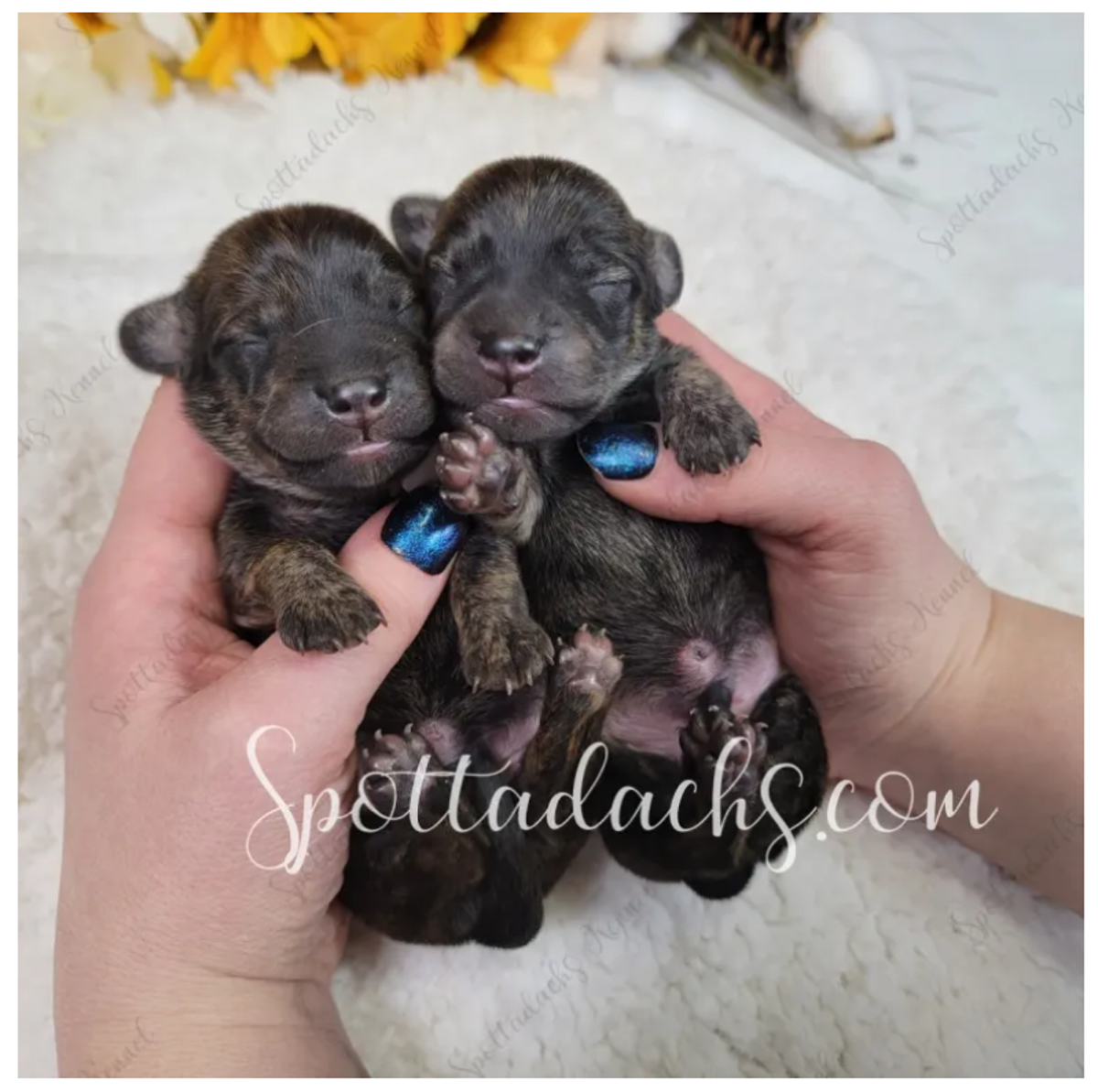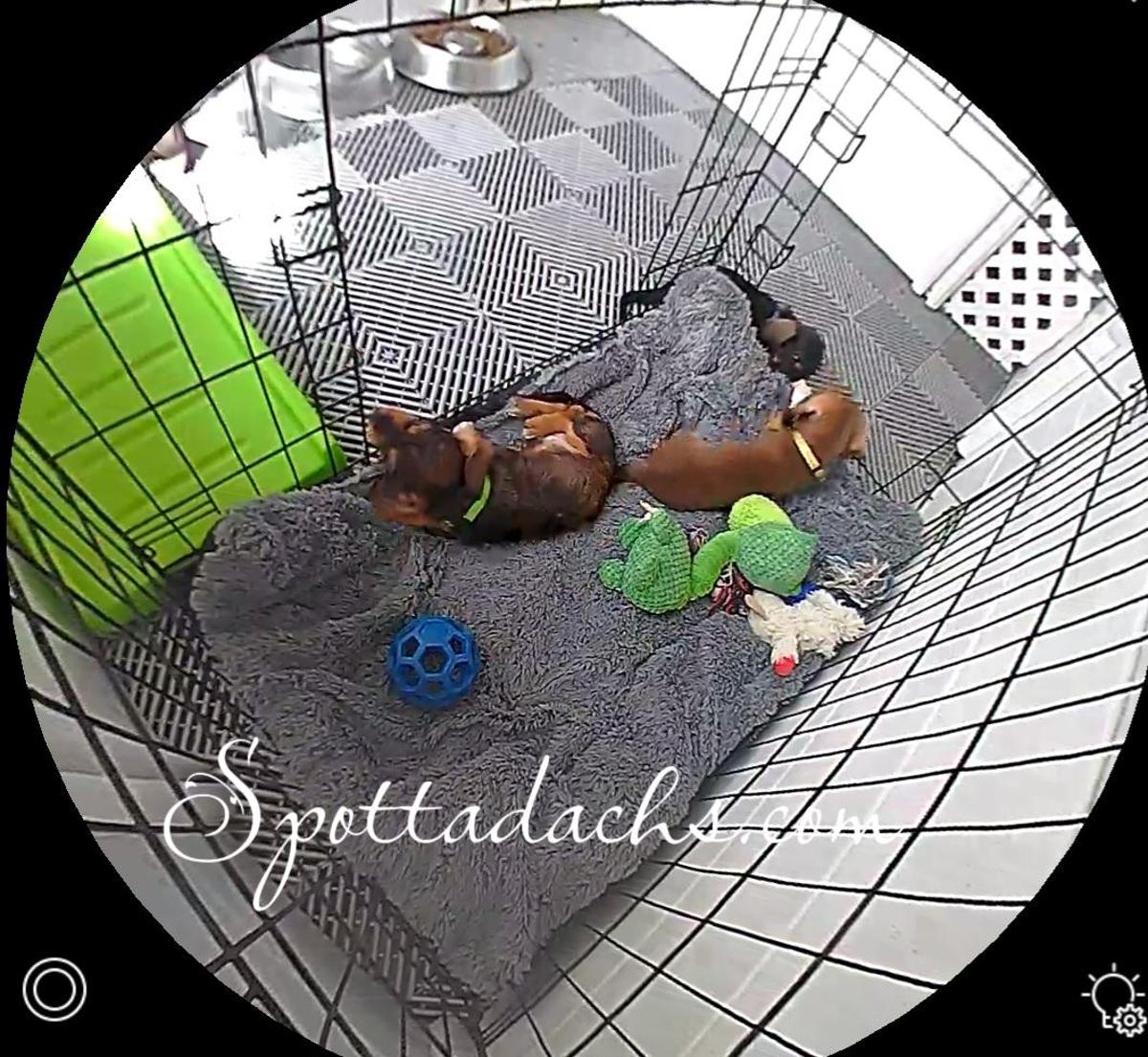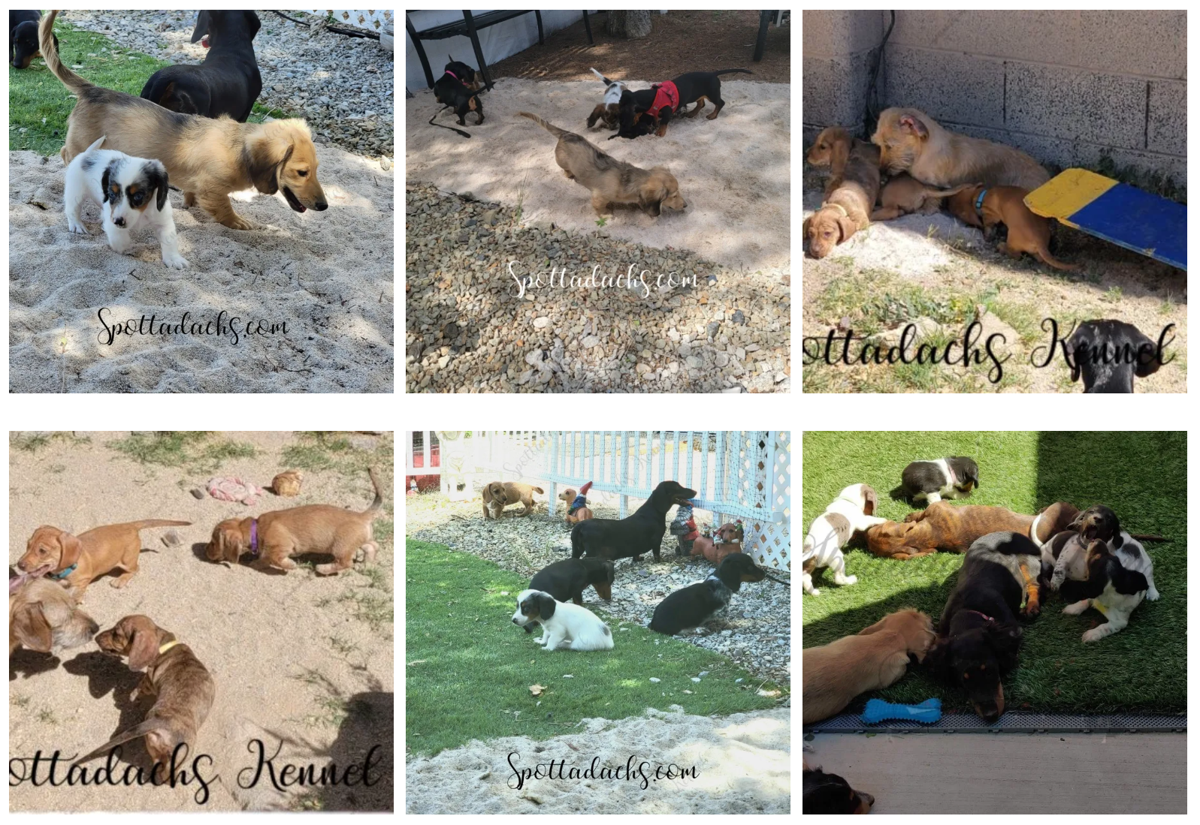Puppy School
What will your puppy know and be used to when it is ready to go home?
Puppy school is what we use to acclimate your puppy to all sorts of new or potentially scary (not dangerous) situations so when they do go out into the big world it is not quite so scary.
During the first week pups are weighed and handled daily to be sure they are growing properly and there are not any issues that might need to be examined by our vet. By touching every part of a puppy's body during this time when touch is one of their strongest senses we are imprinting on them that touch is part of life. It seems so simple but even touch at this early stage is part of puppy school and makes a huge impact on helping them be strong happy dogs later rather than fearful. By helping them learn to be calm while being held on their backs they are preparing for later nail trims or vet examinations.

When the pups are old enough to start moving around they are introduced to a crate bed and more open pen where they are able to touch noses and start observing the social behaviors of the pack while still protecting them from older pups that might play too rough.
During this time we also begin introducing them to new sounds like music, vacuums, sirens, people walking past, dogs barking or playing loudly, typical household noises, etc..

We believe crate training even if it will not be used by the new family is vital for puppies to learn early on in case of evacuation or illness that requires bed rest. Our pups choose to sleep in the crate naturally because it was the first thing they knew. Every step is done at a specific time and in a specific order to help the pups learn it in a manner that feels natural to them. We do not ever lock our puppies in as punishment or alone. Pups under 10 weeks cannot yet make it 12 hours without needing to potty.
As the pups grow their world expands into a larger play room with new sensory development toys and experiences every day. Around 5-6 weeks old we start allowing trusted adults to interact and play with the pups during supervised play times. By learning proper canine social cues they will also learn how to respect the humans in their lives.

The pups we raise experience everything from kids on bikes, vacuuming, and noisy trucks rumbling past, to chickens, bunnies, and cats. We strive to introduce our pups to as much variety (smell, taste, touch, and sound) as we can in a safe manner before they go home with their new families so they are not as stressed as a pup who has been raised in only one situation only would be.
Around 5 weeks the puppies start learning to be without mom for longer and longer periods. This enables her milk to dry up slowly so it is not as painful for her. We let her choose when to nurse or take a break from them.
Once pups have had their first vaccinations they also get to experience the outdoor puppy sensory garden which has things to sniff, taste, feel, hear, and new toys to explore on a puppy-safe level.


We also love to take the pups on walks or bike rides in our enclosed cart where they can smell and see but not be exposed to germs

How to continue once your pup arrives:
House Training
The choice is yours which method you will choose to continue your house training. The most important rule no matter the method is Puppies under 16 weeks should always be taken for potty breaks immediately after waking, eating, or bathing.
When house training our own puppies we do not give them free access until they have mastered returning to the potty area as needed.
If you do not wish to use an indoor potty method you simply take the puppy potty every time they wake up, eat, and/or have a bath those are all guaranteed times they like to potty. We also recommend taking the puppy every 20-30 minutes of awake time until you learn your puppy’s signals so that it can be taken outside before any accidents happen. However, when pottying a young pup outdoors you need to be very aware of germs and predators.
Potty training a puppy is akin to potty training a human child it is as much training yourself the habit as it is for them.
Several of our puppy families have had success with bell training their pups but where we are dealing with training multiple puppies at one time that would be very difficult to achieve en mass.
Feeding
We free-feed our pups starting with soaked kibble at 4 weeks and advancing to a choice between slightly wet and dry kibble by 8 weeks old. They have access to a potty area at all times we do not expect them to be able to hold it overnight for 10-12 weeks minimum.
Starting around four months, puppies can begin eating about three times a day, and after that, puppies will quickly graduate to twice-a-day feedings. Feeding them three or four times per day makes it easier for puppies to digest and help keep energy levels consistent.
A note on Crates:
As far as crates go we have found puppies feel less distraught being crated in the open wire crates over the plastic ones they only have small “window” areas that dachshunds are not tall enough to see out of. However, we do expose our pups to both types after the following story occurred.
We are constantly learning new things to make transitions easier for our puppies.
In one case we did receive a call from a puppy buyer who had tried everything they could think of for a week to keep the puppy from crying and howling ALL night. We talked for an extended time several nights in a row giving suggestions to no avail. Finally, I asked them to send me a picture of their set up maybe I was missing something?
I noticed they were using a plastic kennel/crate which is absolutely not a problem. But in this instance, I suggested maybe they try a wire style. Sure enough that next night barely a peep.
This case was the first I’ve encountered that it made such a big deal but I mention it now because if your preference is a plastic crate we can start getting the puppy used to that style while they are with us rather than at the same time as other big changes are happening. We realize just how important communication with our puppy adopters is for our pups to transition smoothly and prepare for more advanced training as they grow.
We do not have a problem if our buyer’s preference is to let the pups sleep with them we are just striving to lay a foundation for whichever method their new families will choose.
I always suggest a crate for the puppy to escape to if it lives in a busy family with small children. My kids knew growing up with dogs that if it was in its crate it was not to be bothered. Dogs in busy households need a safe space even if the door never closes.
You will learn your pup’s body language and be able to help him out of trouble if he looks stressed or overwhelmed.
Socialization In Their New Home
Socialization and pack behavior is vital in a young pup’s life. Starting with mom and if done properly pups should be introduced to other adults by 6 weeks old to start learning the subtle body language and social hierarchy that a pack would use. This carries on to learn that the people in their lives are the alphas and should be respected and obeyed.
Socializing your pup doesn’t just mean with other dogs though. Introducing your pup to new situations from an early age helps it to not be shy or yippy later in life. We try to introduce your pup to a variety of floor types, as well as things like vacumes, cars and doorbells to help desensitize them.
While curiosity and the ability to learn don’t have expiration dates, young puppies have an important behavioral “sweet spot” between the ages of 8 and 16 weeks. During this critical period, your dog builds impressions and attitudes about what is normal and acceptable. At this time more than any other, positive experiences with the world around it build a solid foundation for the rest of your dog’s life.
However, this is also a time of caution because the puppies’ immune system is changing over from mom’s antibodies to making its own. We have developed a vaccination regimen we feel will give your dog the highest protection by continuing vaccinations every 2-3 weeks instead of waiting four, just to be sure there is no gap. However, you should certainly consult with your vet because he/she will know the outbreaks or more common illnesses in your area.
There are plenty of socialization exercises that can be done from home during that time one of which is especially important is introducing them to new dogs and people (preferably ones that have not been to a dog park or public place earlier that day) so that they do not grow up thinking they own the home and must bark at or act aggressively towards “intruders”.
Puppy kindergartens usually do a good job of sanitizing their buildings but you can always go watch a class without your pup first and observe what kind of precautions are taken. Learning to play rough with other dogs/ and puppies is important but you also want your pup to learn it’s ok to be calm and sit quietly when near other dogs as well.
Puppies pick up on other dog’s behavior and bad habits super quickly so we strongly suggest not allowing your dog to be around incessant barkers, or people aggressive dogs except in controlled situations when those behaviors are hopefully under control. We get a lot of buyers that say OH, I want a puppy now to learn all my old dog’s cute tricks. While this can be a good thing especially for potty training just be aware you may not be happy with the bad behaviors your new addition also picks up.
During the first three months of life puppies should be exposed to as many new people, animals, stimuli, and environments as can be achieved safely and without causing overstimulation manifested as excessive fear, withdrawal, or avoidance behavior.
All socialization is not good socialization. Bad experiences at an early age can make negative impressions for years to come. Sometimes, certain situations are just too much for your puppy. If he is having a good time, he will look the part. Their ears will be up, eyes will be bright, and they may wag their tail or whole body and actively seek interaction. If your puppy is not enjoying himself, learn to recognize signs of stress to avoid causing emotional harm, including:
cowering or clinging
ears down and back
lip licking
sleeping (all young puppies take frequent naps, but if you find your puppy sleeping a lot when you have her out or at a busy event, she may actually be shutting down)
tail tucking
turning the head or body away from people who approach
yawning
Safe Ways to Socialize Before 16 Weeks
Even before your puppy is vaccinated, you can still provide opportunities for him to socialize. Here are some ideas.
– Invite your friends over. Children, adults, men, women, the UPS driver, the gardeners – have your pup see and experience these people in and around your home.
– Take your puppy to a trusted friend’s house. Just going into a new environment will offer your puppy lots of new experiences.
– Invite your friends’ healthy, vaccinated, and puppy-friendly dogs over for a play date. Playing with other dogs is important for puppies’ social development and to learn not to bite hard in play.
– Take your pup on a walk in a stroller, wagon, or sling. Just don’t allow him to walk places where there might be feces or urine from other animals. If you want to start leash training choose a secluded off-path area.
– Take a large blanket or better yet fold up a play-pen to the park. Let your pup watch the world go by in the safety
– Take your pup for car rides. Help him get used to the motion on short rides to the store or even just around the block.
Places NOT to Take Your New Puppy
– PETCO!!! or dog parks
– Any place where he is likely to encounter stray dogs.
– Any place where he is likely to encounter sick dogs.
– Any place where he is likely to encounter aggressive dogs.
– Any place where he is likely to encounter aggressive/rowdy/drunk humans.
– Places where there is an accumulation of feces from unknown dogs.
– Any place he is not welcome.
– Any place where he would have to be left unattended, or in a hot car (no tying up outside the grocery store!).
– Any place where he will be uncomfortable or frightened (sitting in the full sun while you watch your son’s Little League game, at a July 4th fireworks display, at a motorcycle rally, etc).
– Any place where you won’t be able to devote enough attention to him to secure his safety, security, and well-being.
While two- to four-month-old puppies are at the prime age for socialization, their ability to soak up new experiences doesn’t shut off like a faucet once they pass that landmark.
The most critical factor is, don’t stop after 16 weeks, continue on into the first year – especially into adolescence when percolating hormones can create new behavioral challenges.
It’s going to benefit the dog for the rest of his life.